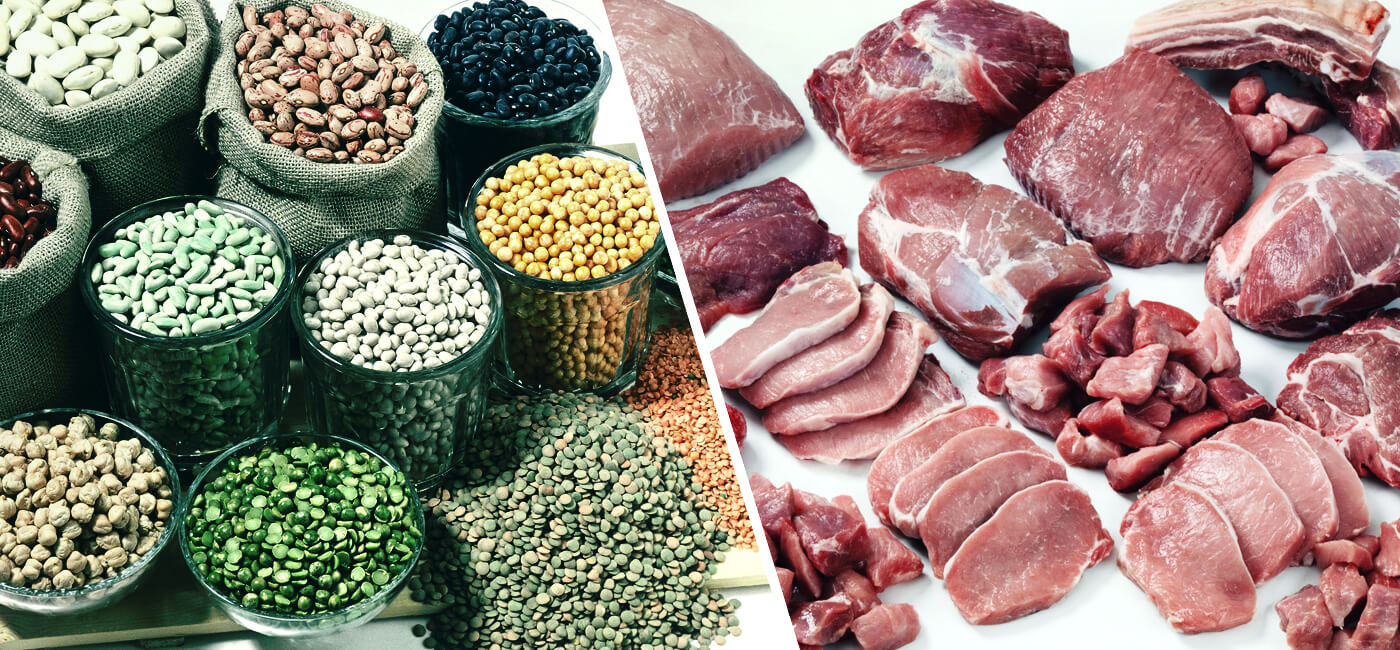Very few topics get more confrontational than advocates on either side of the plant vs animal based lifestyle, with the associated and equally infallible suggestions of comparative superiority in health. As a scientist and practitioner, I am accustomed to living with this uncertainty. Both seemingly polarizing perspectives offer a unique vantage point to some of life’s biggest questions regarding human health and ethical responsibility. Both camps fraught with intoxicating stories seeking conclusions, propelling us down a new path, prompting new questions and ultimately directing us toward a higher summit.
Both choices are equally subjective, entirely reliant on the contextual relevance of the evidence presented. The “right one” can only be true to the individual, no universal extrapolations of personal interpretation should be made accordingly.
Let us establish the proposed question of this article: Is Animal Based protein superior to Plant Based Protein in it’s effect on muscular development?
First off, why is muscle important?
Whether your goals are purely aesthetic or general health you can’t deny the importance of skeletal muscle. To name a few, muscle is the primary driver of:
- Locomotion: capacity to navigate dynamically through space.
- Muscle Strength: ability of the body to impose adequate force against and protect from the external environment. Let’s face it, life is easier when you’re strong.
- Regulation of Blood Glucose: dominant site of glucose disposal, creating a storage depot for energy (glycogen); helping manage blood sugar stability.
- Regulation of Blood Lipids: Similarly, muscle provides both the machinery to oxidize [use] fats to meet immediate energy needs, or store intramuscularly to be used later.
- Basal [resting] Metabolic Rate: BMR is a primary determinant of your energy expenditure throughout the day, for anyone mildly concerned with preventing body fat gain and certainly reduction needs to optimize the amount and activity of this highly metabolically active tissue.
Clearly there are important implications of muscle far beyond it’s physical & functional characteristics. Serving as a metabolic powerhouse, it provides a sink of disposal from otherwise potentially harmful accumulation of sugar and fat. All of these pervasive characteristics of muscle make it an essential component for sustainable fat loss, weight management and consequently long-term health.
In order to comparatively assess Plant versus Animal based protein’s effect on skeletal muscle, the following would have to be evaluated:
- Using viable measures of quality, we would need to assess respective protein source’s effect on Muscle Protein Synthesis after ingestion.
- When measuring isonitrogenous (equal protein) amounts of competing protein sources, we would need to see similar outcomes on Muscle Hypertrophy/Growth.
Fortunately, we have techniques sensitive enough to elucidate these two considerations, establishing meaningful benchmarks of quality in regards to a protein sources anabolic potential on skeletal muscle. Based on the available literature, the prevailing dominant influencers are:
- Essential Amino Acid (EAA) profile of the protein source [1][4]
- Availability of these Amino Acids after Digestion and Absorption to the periphery (i.e. skeletal muscle), providing signals and substrate to repair and rebuild new proteins [2][3].
First things first, what are the comparable profiles of Amino Acids?
| Source1 | Essential amino acids, % total protein | Leucine, % total protein | Lysine, % total protein | Methionine, % total protein |
|---|---|---|---|---|
| Plant sources | ||||
| Spirulina2 | 41 | 8.5 | 5.2 | 2.0 |
| Mycoprotein3 | 41 | 6.2 | 6.7 | 1.5 |
| Lentil2 | 40 | 7.9 | 7.6 | 0.9 |
| Quinoa2 | 39 | 7.2 | 6.5 | 2.6 |
| Black bean2 | 39 | 8.4 | 7.3 | 1.6 |
| Maize2 | 38 | 12.2 | 2.8 | 2.1 |
| Soy2 | 38 | 8.0 | 6.2 | 1.3 |
| Pea5 | 37 | 7.8 | 6.3 | 1.6 |
| Rice2 | 37 | 8.2 | 3.8 | 2.2 |
| Oat2 | 36 | 7.7 | 4.2 | 1.9 |
| Hemp6 | 34 | 6.9 | 4.1 | 2.3 |
| Potato2 | 33 | 5.2 | 5.7 | 1.7 |
| Wheat7 | 30 | 6.8 | 2.8 | 1.9 |
| Animal sources | ||||
| Whey8 | 52 | 13.6 | 10.6 | 2.3 |
| Milk8 | 49 | 10.9 | 8.6 | 2.7 |
| Casein8 | 48 | 10.2 | 8.1 | 2.7 |
| Beef8 | 44 | 8.8 | 8.9 | 2.5 |
| Egg9 | 44 | 8.5 | 7.1 | 3.0 |
| Cod10 | 40 | 8.1 | 8.8 | 3.0 |
| Human muscle8 | 45 | 9.4 | 8.7 | 2.2 |
When we’re assessing the EAA composition of a protein source we use the ratio found in Human Skeletal muscle as the optimal benchmark (Blue arrow). Needing each in sufficient quantity. It’s these particular amino acids that ultimately dictate the strength of signal to the muscle to begin building (MPS), as well as the precise tools necessary to make it happen. Although all amino acids are required to build new muscle, essential amino acids cannot be synthesized (made) in the body, thus are fundamentally required from the diet.
Referencing the table, you can see quite clearly that plant based sources fail to meet the mark, whereas animal sources achieve and exceed the established thresholds.
But remember it’s not just the initial profile of EAA, but how many ultimately become available to the periphery to support the repair and remodeling of skeletal muscle. Unfortunately, there is a strong indication from the literature that the divergence between animal and plant based sources increase dramatically at this stage.
Of the seemingly inferior EAA profile evident in plant based sources, to further attenuate its muscle building potential, there is an impaired ability to adequately digest and absorb them, 45-80%, compared to > 90% in that of animal based sources. This inefficiency is purportedly due to “anti-nutritional” factors that interfere with digestion and absorption. Whether it’s primarily driven by high levels of insoluble fiber, trypsin inhibitors or tannins in legumes, the consequently impaired digestibility of these protein fractions appears founded [5][6][7]. Less clear, is something distinct in the “unbalanced” EEA profile of the plant based sources that drive increased oxidation of these amino acids in the mitochondria.
Bringing it all together, when comparing protein sources consumed individually in whole food form, plant sources start with less EAA, lose more EAA en route to muscle, and demonstrate a tendency to be extracted by other tissues before making their anabolic impact on muscle (splanchnic/gut tissue, urea production and oxidation). Multiple factors synergistically working to reduce our capacity for muscle growth.
Now there are some strategies to enhance any perceived deficiency of plant based sources:
- Consume more plant based options, in an effort to achieve EAA benchmarks by sheer quantity:
- Considering the macronutrient characteristics of plant sources (particularly high in carbohydrates, potentially fat) – Could this over consumption result in unwanted weight gain and/or drive further Amino Acid oxidation and extraction by other tissues?
- Combine multiple sources to mimic the optimal EAA composition:
- a. Who reading this article, off hand, in real-time could determine which plants and how many would be required on a meal by meal basis to effectively leverage this strategy?
…Or, you can simply go eat a steak.
However, it’s important to note, most of the literature available on plant based protein utilizes isolated sources (i.e. soy, maize, rice, etc.) rather than a combination of protein dense whole foods that better reflect standard dietary patterns. Future research, partly done in our lab at the University of Illinois, needs to elucidate whether protein dense mixed meals comprised solely of plant based proteins, collectively encompassing an optimal EAA profile can equally augment the adaptive response of skeletal muscle when compared to animal based counterparts. A fundamentally relevant comparison with an elevated practical utility for this central question.
Disclaimer, nothing in this article is considering the issue of economic and environmental sustainability; arguably a more pertinent and impactful facet of this discussion. But today, rather than focus on such ambitious pursuits, we aimed to hone our discussion towards efficacy in improving skeletal muscle function and health.
References
- Volpi E, Kobayashi H, Sheffield-Moore M, Mittendorfer B, Wolfe RR. Essential amino acids are primarily responsible for the amino acid stimulation of muscle protein anabolism in healthy elderly adults. Am J Clin Nutr 2003;78:250-8.
- Pennings B, Boirie Y, Senden JM, Gijsen AP, Kuipers H, van Loon LJ. Whey protein stimulates postprandial muscle protein accretion more effectively than do casein and casein Hydrolysate in older men. Am J Clin Nutr 2011;93:997-1005.
- Koopman R, Crombach N, Gijsen AP, Walrand S, Fauquant J, Kies AK, Lemosquet S, Saris WH, Boirie Y, van Loon LJ. Ingestion of protein Hydrolysate is accompanied by an accelerated in vivo digestion and absorption rate when compared with its intact protein. Am J Clin Nutr 2009;90:106-15.
- Tipton KD, Gurkin BE, Matin S, Wolfe RR. Nonessential amino acids are not necessary to stimulate net muscle protein synthesis in healthy volunteers. J Nutr Biochem 1999;10L89-95.
- FAO. Report of a sub-committee of the 2011 FAO Consultation on “Protein Quality Evaluation in Human Nutrition”: the assessment of amino acid digestibility in foods for humans and including a collation of published ideal amino acid digestibility data for human foods. Rome (Italy): FAO;2012.
- Rutherfurd SM, Moughan PJ. Available versus digestible dietary amino acids. Br J Nutr 2012;108: suppl 2:s2989-305.
- Sarwar Gilani G, Wu Xiao C, Cockell KA. Impace of Antinutritional factors in food proteins on the digestibility of protein and the bioavailability of amino acids and on protein quality. Br J Nutr 2012;108: supple 2:S315-32

